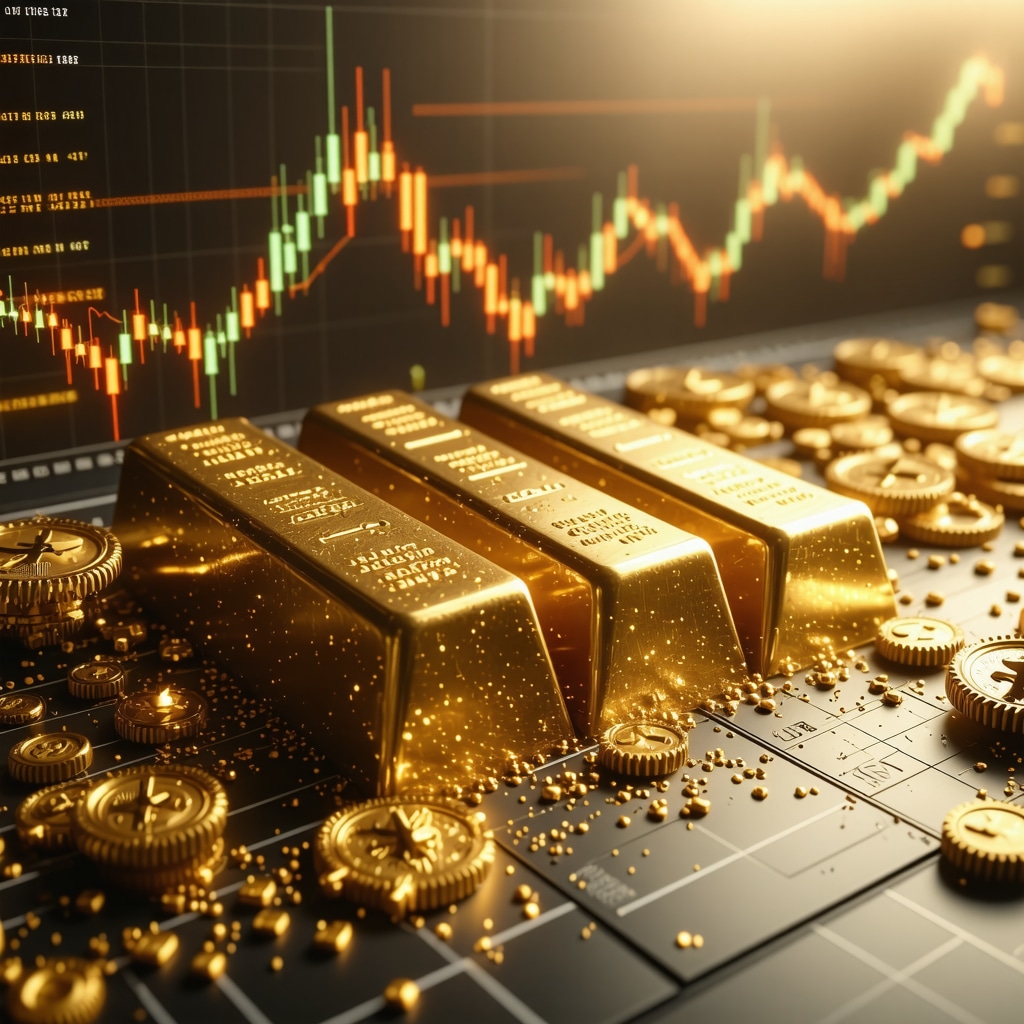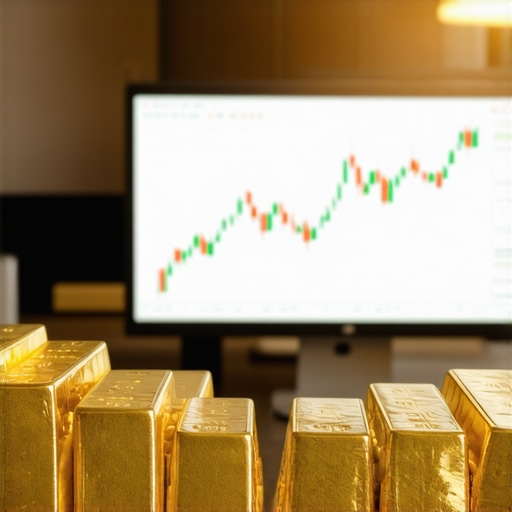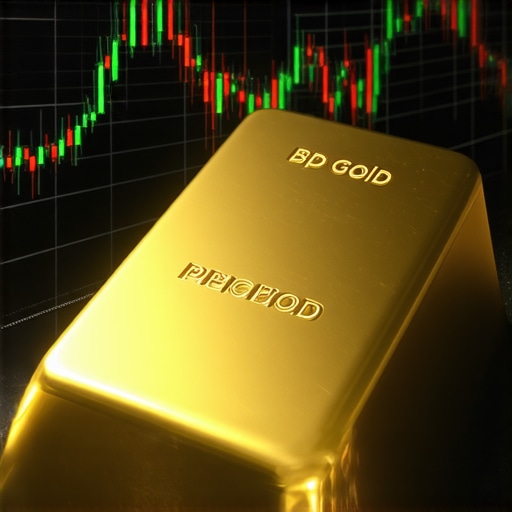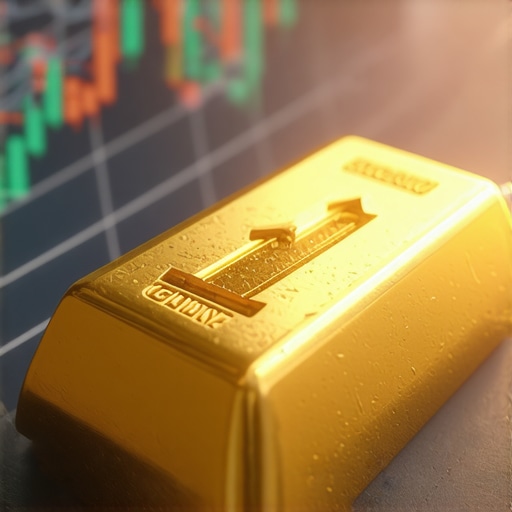Glimpsing the Future: Why 2028 Is a Crucial Year for Gold Investors
As we delve into the gold price forecast for 2028, investors and market watchers alike stand at a crossroads of uncertainty and opportunity. Gold, long revered as a hedge against inflation and a safe haven asset, faces a complex interplay of economic, geopolitical, and technological factors that will shape its trajectory over the next several years. Understanding these forces with an expert lens is essential for making informed decisions in an ever-evolving financial landscape.
Global Economic Ripples: The Understated Pulse Behind Gold’s Value
One of the most potent drivers of gold price movements is the global macroeconomic environment. Inflation trends, real interest rates, and currency fluctuations—especially the strength of the US dollar—are pivotal. Historically, when inflation accelerates and real yields fall, gold tends to shine brighter as an inflation-resistant asset. For instance, the post-2020 inflation surge highlighted gold’s role as a portfolio stabilizer amid volatile markets.
Looking ahead to 2028, central banks’ monetary policies will be decisive. Should inflation persist or central banks adopt dovish stances, gold prices could gain momentum. Conversely, tightening monetary policies might temper gold’s appeal. This nuanced dance between inflation expectations and interest rates underscores the necessity for investors to monitor central bank signals closely.
Geopolitical Tensions and Their Quiet Yet Powerful Influence on Gold
Gold often flourishes amid uncertainty, and geopolitical tensions remain a silent catalyst. Conflicts, trade disputes, and shifts in global power balances inject risk premium into gold prices. The ongoing recalibration of alliances and emerging market uncertainties can elevate gold demand as a safe-haven asset. For example, recent geopolitical frictions have boosted central bank gold reserves as part of strategic diversification.
How Do Technological Advancements and Supply Constraints Shape Gold’s Future?
Beyond demand-side factors, the supply dynamics of gold are equally critical yet often overlooked. Technological advances in mining and refining can enhance supply efficiency, but geological constraints and environmental regulations may limit output growth. Moreover, innovations like blockchain-based gold trading platforms are reshaping accessibility and liquidity, potentially impacting market behavior.
This duality—where supply might tighten while technology expands market access—creates a unique tension that could lead to heightened price volatility. Investors should pay attention to mining sector trends and emerging technologies that influence gold’s supply chain and market participation.
Investor Behavior and Emerging Market Demand: The New Frontiers
Emerging markets, particularly in Asia, continue to fuel global gold demand through cultural affinity and growing wealth. As middle classes expand, both jewelry and investment demand surge, influencing price dynamics significantly. Coupled with this is a shift toward digital gold investments, including ETFs and gold-backed digital assets, which democratize access but also introduce new volatility factors.
Seasoned investors recognize that tracking these demand trends—especially in rapidly developing economies—offers a strategic edge. For a deeper dive into these evolving demand patterns, consider exploring understanding gold demand trends in emerging markets.
Strategic Moves: How Should Investors Prepare for Gold in 2028?
With the multifaceted factors at play, a diversified approach to gold investment becomes prudent. Combining physical bullion, ETFs, and selective mining stocks can optimize risk-adjusted returns. As market volatility looms, employing advanced trading techniques and staying abreast of supply-demand analyses are invaluable. Our comprehensive insights on preparing your portfolio for change in 2028 provide practical strategies tailored for this evolving landscape.
In the dynamic world of gold investing, staying informed and adaptable is key. We invite you to share your thoughts or questions below and join a community committed to mastering gold market intricacies for long-term success.
For authoritative insights on gold’s macroeconomic drivers, the International Monetary Fund’s World Economic Outlook remains an indispensable resource.
Reflecting on My Journey with Gold Amid Changing Market Dynamics
Over the years, I’ve witnessed firsthand how gold can serve not just as an investment, but as a lifeline during turbulent times. I remember during the economic fluctuations in the early 2020s, my diversified gold holdings, including physical bullion and ETFs, provided a cushion against volatile stock markets. It was not just about preserving wealth but about peace of mind. This experience has deepened my appreciation for a well-rounded gold portfolio and staying updated with evolving trends.
Embracing Digital Gold: A Double-Edged Sword?
The rise of digital gold platforms has been fascinating to observe. They make gold more accessible than ever, allowing investors to buy fractional shares or even trade gold-backed tokens seamlessly. However, my experience taught me that with ease comes volatility. The liquidity and speed of digital transactions can amplify price swings, especially when market sentiment shifts rapidly.
In fact, a recent International Monetary Fund report highlights how digital assets linked to gold are reshaping investment behaviors globally, especially in emerging markets. This intersection of technology and traditional assets is creating new opportunities but also demands a cautious approach.
What Role Does Physical Gold Play When Digital Alternatives Are Rising?
Despite the allure of digital gold, I remain a firm believer in the tangible security that physical gold offers. Holding gold bars or coins — something you can see and store safely — adds a layer of trust that digital platforms can’t fully replicate. It’s akin to having a safety net that doesn’t rely on internet connectivity or third-party systems.
If you’re curious about the safest ways to acquire physical gold, my guide on physical gold bullion buying can walk you through the essentials, from choosing reputable dealers to secure storage tips.
How Can Investors Balance Tradition and Innovation in Gold Investing?
This question often crosses my mind, especially as younger generations gravitate toward tech-savvy investment methods. From my perspective, a hybrid approach is key. By blending physical gold for stability with digital instruments for liquidity and ease, investors can craft portfolios that are both robust and adaptable.
Moreover, keeping tabs on supply constraints—like mining limitations and regulatory changes—helps anticipate price movements. For those eager to dive deeper into these market forces, exploring gold supply and demand trends offers valuable insights.
Invitation to Share Your Gold Investment Experiences
Gold investing is as much a personal journey as it is a financial strategy. I’d love to hear how you navigate this landscape—whether you prefer physical assets, digital platforms, or a mix of both. What lessons have shaped your approach? Feel free to share your stories or questions in the comments below. Let’s build a community where we learn and grow together.
Decoding Market Volatility: Expert Techniques to Shield Your Gold Portfolio
Market volatility is an inevitable companion in the gold investment journey, especially as we approach 2028 with its unique blend of economic uncertainty and technological disruption. Sophisticated investors employ a range of advanced strategies — including options hedging, dynamic asset allocation, and volatility targeting — to mitigate risk and capitalize on gold’s safe-haven status.
For instance, options contracts such as gold puts and calls can act as insurance policies, allowing portfolio managers to protect against downside risk while maintaining upside potential. Additionally, tactical shifts in allocation between physical gold, mining equities, and gold ETFs can respond to short-term market signals without sacrificing long-term positioning.
Understanding implied volatility metrics and their relationship to gold futures markets is equally critical. This expertise enables investors to anticipate and profit from short-term price swings rather than merely reacting to them. To deepen your grasp on these techniques, the CFA Institute’s advanced portfolio management guide offers a thorough analysis.
Integrating ESG Factors: The Rising Influence of Sustainable Mining on Gold Valuation
Environmental, Social, and Governance (ESG) criteria are reshaping the gold mining landscape, profoundly impacting valuation and investor sentiment. Mining companies that prioritize sustainable practices, ethical sourcing, and community engagement often command premium valuations due to reduced regulatory risks and stronger brand reputations.
As ESG regulations tighten globally, gold investors must scrutinize mining companies’ ESG disclosures and scorecards. Those lagging risk operational disruptions and reputational damage, which can manifest as increased cost structures or diminished stock performance. Conversely, ESG leaders attract capital inflows from dedicated sustainable funds, enhancing liquidity and valuation.
This paradigm shift calls for integrating ESG analysis into gold investment decision-making frameworks. For a comprehensive understanding of this trend’s financial implications, the MSCI ESG Research report on gold mining is a must-read resource.
How Do Macroprudential Policies Affect Gold Prices Beyond Traditional Monetary Tools?
Macroprudential policies—such as capital requirements, leverage limits, and systemic risk buffers—are increasingly influential in shaping gold market dynamics. Unlike conventional monetary policy, which directly alters interest rates or money supply, macroprudential tools affect financial stability and credit cycles, indirectly impacting gold demand.
For example, tighter bank capital regulations can constrain credit availability, dampening economic growth and elevating safe-haven demand for gold. Similarly, systemic risk buffers aimed at reducing market fragility can increase gold’s role as a portfolio stabilizer during financial shocks.
Understanding these nuanced policy impacts requires monitoring regulatory developments across jurisdictions and their cascading effects on market liquidity and investor behavior.
Harnessing Data Analytics and AI: The Frontier for Predictive Gold Market Models
The fusion of big data analytics and artificial intelligence (AI) is revolutionizing gold market forecasting. Traditional models relying on macroeconomic indicators and historical trends are increasingly supplemented or replaced by machine learning algorithms capable of processing vast datasets—from satellite mining activity to social media sentiment.
These models can uncover non-linear relationships and early signals of market shifts, offering investors a powerful edge. For instance, AI-driven sentiment analysis can detect emerging geopolitical risks or shifts in investor confidence before they materialize in prices.
Investors aiming to leverage these innovations should consider integrating AI-powered analytics platforms into their toolkit, complementing fundamental and technical analyses for a holistic approach.
Are you ready to elevate your gold investment strategy with cutting-edge tools and insights? Explore our advanced resources and join a network of expert investors committed to mastering the complexities of the gold market in 2028 and beyond.
Incorporating ESG Metrics: The New Gold Standard for Ethical Investors
As Environmental, Social, and Governance (ESG) considerations escalate in prominence, their integration into gold investment frameworks becomes indispensable. Investors must evaluate mining companies not only on traditional financial metrics but also on their sustainability practices, community impact, and governance transparency. Such scrutiny reduces exposure to regulatory penalties and reputation risks, while positioning portfolios to benefit from the premium valuations that ESG leaders command. This evolution demands a paradigm shift from conventional valuation models to those embracing non-financial criteria as key performance indicators.
Macroprudential Policies: An Underexplored Driver of Gold Market Volatility
Beyond classical monetary policy, macroprudential tools such as systemic risk buffers, leverage constraints, and capital adequacy requirements have emerged as subtle yet powerful influences on gold’s price trajectory. By modulating financial stability and credit conditions, these policies indirectly affect investor appetite for safe-haven assets. For example, heightened capital requirements during periods of financial tightening can curtail economic expansion, thereby amplifying gold demand as a defensive instrument. Comprehensive vigilance over global regulatory shifts is thus critical for adept portfolio management.
How Can Advanced AI and Big Data Analytics Revolutionize Gold Price Forecasting?
The integration of artificial intelligence and big data analytics into gold market models heralds a transformative era in predictive accuracy. Machine learning algorithms assimilate heterogeneous datasets—from satellite imagery of mining operations to real-time social media sentiment—unveiling complex, nonlinear patterns imperceptible to traditional analyses. These models empower investors to anticipate geopolitical upheavals, supply disruptions, and demand surges with unprecedented lead time. Incorporating AI-driven insights into investment strategies can substantially enhance risk-adjusted returns and adaptability in volatile markets.
For a rigorous exploration of these methodologies, consider the CFA Institute’s advanced portfolio management guide, which offers an authoritative roadmap on leveraging these cutting-edge techniques.
Engage with Cutting-Edge Expertise: Elevate Your Gold Investment Acumen
Embracing these advanced dimensions—ESG integration, macroprudential policy analysis, and AI-powered forecasting—positions investors at the vanguard of gold market mastery. We invite you to deepen your understanding and refine your strategies by engaging with our comprehensive resources and expert community. Share your perspectives or queries below to catalyze a dialogue that fosters collective wisdom and sustained investment excellence.
Frequently Asked Questions (FAQ)
What factors most strongly influence gold prices in 2028?
Gold prices in 2028 will be shaped by a complex interplay of global macroeconomic conditions such as inflation and real interest rates, geopolitical tensions that increase safe-haven demand, technological advances affecting mining supply, and evolving investor behavior including digital gold adoption and ESG considerations.
How do geopolitical events affect gold’s role as an investment?
Geopolitical instability often drives investors toward gold as a safe haven, boosting demand and price. Conflicts, trade disputes, and shifts in global power dynamics add risk premiums that elevate gold’s appeal during uncertain times.
What impact do technological advancements have on gold supply and trading?
Technological innovations improve mining efficiency and enable new trading platforms like blockchain-based gold assets, enhancing liquidity and accessibility. However, environmental regulations and geological constraints may limit supply growth, creating potential price volatility.
Why is ESG integration becoming crucial in gold investing?
ESG factors influence mining companies’ valuations by affecting operational risks and investor sentiment. Sustainable practices and ethical sourcing reduce regulatory exposure and attract capital from ESG-focused funds, making ESG analysis essential for modern gold portfolios.
How can investors mitigate gold market volatility approaching 2028?
Advanced strategies such as options hedging, dynamic asset allocation, and volatility targeting help manage risk. Combining physical gold with ETFs and mining stocks, while monitoring implied volatility metrics, allows for responsive and balanced portfolio management.
What role do macroprudential policies play in gold price dynamics?
Macroprudential tools like capital requirements and leverage limits indirectly affect gold demand by influencing financial stability and credit conditions, thereby shaping investor appetite for gold as a defensive asset beyond traditional monetary policy effects.
How are AI and big data changing gold price forecasting?
AI-powered models analyze vast, diverse datasets to detect subtle patterns and early signals in gold markets. This enhances predictive accuracy, enabling investors to anticipate geopolitical risks, supply disruptions, and demand shifts with greater lead time.
Should investors prefer physical gold or digital gold platforms?
A hybrid approach is advisable. Physical gold offers tangible security and trust, while digital platforms provide liquidity and ease of access. Balancing both allows investors to leverage the strengths of each amid evolving market conditions.
How does emerging market demand influence gold prices?
Rising middle classes in emerging markets, especially in Asia, drive sustained demand for both jewelry and investment gold. This cultural affinity and wealth growth significantly impact global price trends.
What are the best resources for staying informed about gold market trends?
Trusted resources include the International Monetary Fund’s World Economic Outlook for macroeconomic insights, CFA Institute publications for advanced portfolio techniques, MSCI ESG Research for sustainability in mining, and specialized reports on supply-demand trends and technological impacts.
Trusted External Sources
- International Monetary Fund (IMF) – World Economic Outlook: Provides authoritative analysis on global macroeconomic conditions influencing gold prices, including inflation forecasts and monetary policy trends.
- CFA Institute – Advanced Portfolio Management Guides: Offers expert insights on sophisticated investment strategies, risk management, and the integration of precious metals into diversified portfolios.
- MSCI ESG Research – Gold Mining Analysis: Delivers comprehensive evaluations of environmental, social, and governance practices within gold mining companies, critical for understanding ESG impacts on valuation.
- World Gold Council: A leading industry authority providing data, research, and market intelligence on gold demand, supply, and investment trends worldwide.
- Specialized Academic Journals and Financial Data Providers: Sources such as the Journal of Commodity Markets and Bloomberg terminals offer cutting-edge research and real-time analytics essential for in-depth gold market analysis.
Conclusion: Embracing Complexity for Informed Gold Investment in 2028
Forecasting gold prices in 2028 demands a nuanced understanding of interconnected forces — from macroeconomic shifts and geopolitical uncertainties to technological innovations and ESG imperatives. Gold’s enduring appeal as a hedge and safe haven remains intact, yet investors must skillfully navigate emerging trends including digital gold platforms and AI-driven market analytics. A balanced, diversified strategy that integrates physical assets with technological and sustainability considerations offers the most resilient pathway forward.
By staying informed through reputable sources and adopting advanced risk management techniques, investors can capitalize on gold’s dynamic landscape and safeguard their portfolios against volatility. We encourage you to share your insights, engage with expert communities, and explore our resources to deepen your mastery of the gold market as 2028 approaches. Harness this knowledge to make confident, strategic decisions in an evolving financial world.










